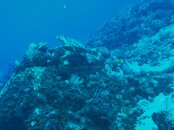mike--Hmmm, well yeah. P'shop is not simple--but there are some simple things that can be done with it. I'm wondering though about the "when I have my pictures developed" comment. Are you saying you get the files to look good in PS but when someone else prints them they look not so good? That sounds like a monitor calibration issue but I'm not sure that that is what you are saying.
You'll hear "get a strobe" and sure, world of difference. Not having one though, what you can do w/ RAW files is very flexible. However, you are starting from a very color shifted situation when dealing w/ available light uw and there are limits. I did a quick "fix" (see attch'd) on one of yours. Of course everyone has their own approach and
Color Balance under
Image>Adjustments is probably best to start with but I tend to also use "
Channel mixer" a lot. You'll find it under
Image>Adjustments>Channel Mixer (about half way down the menu list--though I use CS not CS3 so there may be some changes). There are 3 sliders for Source Channels(RGB) and 3 options for output (yep, RGB).
Sounds complicated. Isn't. Slide 'em and see. Work your way through each output channel using all 3 slider options--otherwise things will look so bad you'll stop at the first one! Be prepared to mess around and play with them, use a duplicate image to avoid accidents. And use
Adjusment Layers for gosh sakes (the option is at the bottom of the
Layers Palette, looks like a diagonal half moon symbol).
Adjustment Layers WON'T mess w/ the image pixels themselves, so it is way faster on big files and also completely editable at any time, including just shutting it off.
I'm sure you've tried
Auto Levels and
Auto Color under
Image>Adjustments and sometimes they help but usually not much--or not enough. Playing w/ other image adjustments yourself is the ticket. Using adjustment layers makes this fast and forgiveable. You can always flatten these layers later if you need a jpeg etc. Oh and why bother editing jpegs? If you shoot RAW and edit w/ RAW files you will ALWAYS have more information to edit and correct, unlike compressed jpegs.
If none of this makes much sense you might want to ck some of the many online p'shop tutorials for basic help before you tackle specific editing tasks but that's just a suggestion. Like most aspects of life, everyone will have an opinion of "what works best" for color correction issues. I happen to like and use Channel mixing a lot but there are plenty of ways to do the same thing in PS. Have fun.

// ww






 // ww
// ww


